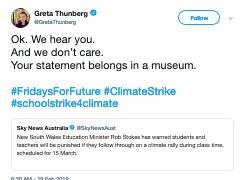Thousands of young climate change activists in at least 98 countries will skip school on March 15 in what may be one of the biggest environmental protests in history.
“We are the voiceless future of humanity,” activists wrote in a letter published March 1 by the Guardian. “Now we will make our voices heard. On 15 March, we will protest on every continent.”
The strikes kicked off last year with one Swedish girl protesting outside Swedish Parliament, and already students in the United Kingdom, Australia, France, Germany, Ireland, Uganda, Thailand, Colombia, and Poland have followed her lead, playing hooky to demand stronger action on climate change from their governments.


The movement has now spread to the United States, where March 15 strikes are planned in more than 100 cities, organized under the leadership of three girls: Alexandria Villasenor, Haven Coleman, and Isra Hirsi, daughter of the headline-making first-term Rep. Ilhan Omar (D-MN). Omar tweeted she will attend the strike in Washington, DC, on Friday.

This wave of youth activism began with 16-year-old Greta Thunberg from Sweden, who last August began camping outside the Swedish parliament and accused lawmakers of failing to uphold their commitments to fight climate change as agreed to under the Paris climate accord.
According to the Guardian, Thunberg “was inspired by students from the Parkland school in Florida, who walked out of classes in protest against the US gun laws that enabled the massacre on their campus.”
As word of her strike spread, she became an international celebrity, and was invited to speak to climate negotiators in talks last December in Poland and more recently to the global elite in Davos, Switzerland. “I don’t want your hope,” she said in her Davos speech. “I don’t want you to be hopeful. I want you to panic. I want you to feel the fear I feel every day. And then I want you to act.” She has continued striking every Friday, inspiring the Fridays for Future movement in dozens of other countries too.
Thunberg, who has Asperger syndrome, has managed to both channel and elevate the frustration and fear many young people feel about policymakers’ reticence to take climate change really seriously. Scientists warn that the impacts of climate change like extreme weather are already deadly and damaging, and that we have just 12 years to limit devastating worldwide warming. People under age 20, of course, could be around to see 2080, and face the prospect of a planet that has warmed on average by 2 or even 4 degrees Celsius in their lifetimes.
The strikers around the world have slightly different demands, but the common theme is that they want their governments to aggressively cut their greenhouse gas emissions. Thunberg was able to pressure European Commission President Jean-Claude Juncker to commit to spending 1 trillion Euros to mitigate climate change between 2021 and 2027. But she will continue striking until Swedish parliament strengthens its own climate commitments.
Some strikers also want a greater say in the political process with a lower voting age.
But right now, schoolchildren can’t vote and some of the “grownups” are dismissive of their concerns and tactics UK Prime Minister Theresa May last month said the protests “increases teachers’ workloads and wastes lesson time that teachers have carefully prepared for.” An Australian education minister threatened to punish students who strike on March 15, prompting a sharp retort from Thunberg on Twitter.

As Coleman, one of the US organizers, told Vice, “I’m not going to leave my future in the hands of people who aren’t doing anything. We’re already seeing the effects [of climate change], you can see it everywhere. You might even see it in your backyard… We’re just trying to survive.”
So how can these student strikers build on their momentum?
Columnist George Monbiot, writing in the Guardian, argued that the activists could start supporting clear targets and policy frameworks, like a zero-carbon economy or the Green New Deal. It could be analogous to how some of the high school students who survived the 2018 school shooting in Parkland, Florida have driven a national conversation on gun control, though it has yet to be matched with enough legislative action.
The climate strikes should also establish a set of anchoring principles to guide activism, and to hold decision-makers to account, noted Monbiot. One “crucial element,” he says, is “a protest community strong enough to resist all attempts at division and co-option.”
The strikes are revealing the solidarity of young people concerned about the environment, showing that they aren’t alone. And soon enough, these schoolchildren will be old enough to vote, and public officials will have to answer to a highly-motivated bloc for what they did or didn’t do to address a foundational problem for the next generation.
Activists are now coordinating more strikes around the world, including the main strike on March 15. This map highlights some of the upcoming strikes around the world, and a map of the US strikes can be found here.
ZNetwork is funded solely through the generosity of its readers.
Donate
